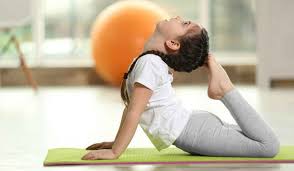We want children to grow better and experience wholesome brain development. For this, yoga is important as it works on both the physical body as well as the mind.
We often ask our children to pay attention. "Pay attention to your schoolwork, pay attention to your father, pay attention to your teacher," but we don’t have a clear idea of what we are actually asking them to do.
When we ask our children to pay attention, what we really mean is something along the lines of, "Stop thinking about all the other things that are important to you right now, no matter how you are feeling about those things – even if they are scary, confusing, or are trying really hard to distract you. Focus exclusively on what I want you to focus on and then respond in a way that is productive and socially appropriate."
 A Child’s Brain with Yoga:
A Child’s Brain with Yoga:
What we are asking our kids to do is very hard. In order to pay attention to any one thing, a person must filter an enormous amount of other things: all the external stimuli (including the ongoing assault of technology), as well as all the internal thoughts, feelings, memories, and plans. We are always paying attention to something. What we are trying to do, and teach our kids to do, is to choose what we pay attention to and for how long we pay attention to it. The brain is our learning center and is the seat of all our habits, thoughts, and memories. In order to bring about any kind of transformation in life, it is the brain that we must target first.
Yoga is known for being a slow, methodical practice. Parents may wonder if such slow and deliberate movements can really help their kids, especially if kids are more spirited than average or lack patience. It turns out that the gentle pace of yoga actually has a calming effect on many kids with short attention spans and a lot of energy. Many yoga programs are specifically developed for children and may incorporate more movement than traditional yoga as well.
Regular yoga practice helps children sharpen focus and attention, which are essential for academic success and daily activities. These poses improve cognitive skills and physical coordination.
Practicing yoga can be incredibly beneficial for kids, offering a range of advantages that go beyond physical fitness. It plays a significant role in enhancing cognitive skills such as concentration, memory, and emotional regulation. Through consistent practice, yoga helps children develop better focus and attention, which are crucial for academic success and everyday tasks. The mindful breathing and relaxation techniques incorporated in yoga can improve memory retention and recall. Moreover, yoga encourages self-awareness and emotional regulation, teaching kids how to manage stress and emotions effectively.
Types of Yoga for Kids:
- Cat-Cow Pose (Marjaryasana-Bitilasana)
- Downward-Facing Dog (Adho Mukha Svanasana)
- Child’s Pose (Balasana)
- Butterfly Pose (Baddha Konasana)
- Cobra Pose (Bhujangasana)
- Easy Pose (Sukhasana)
Tips for Practicing Yoga with Kids:
- Make it fun and engaging by incorporating stories or themes into the poses.
- Encourage deep, mindful breathing.
- Practice in a quiet, distraction-free environment.
- Keep sessions short and playful, gradually increasing the duration as kids become more comfortable.
